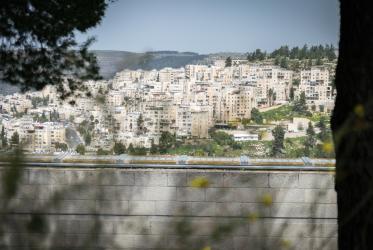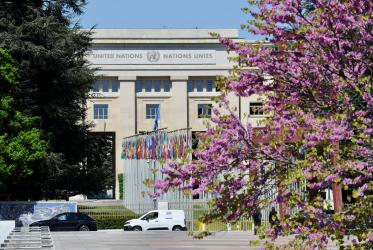CCIA Background Information on International Affairs, 22 August 2005
This brief provides information to help churches discern what is happening in
Israel and Palestine now and in the months ahead. It is also an invitation for member
churches and ecumenical partners to watch, pray and act for peace guided by
the deep commitment within the WCC fellowship to the legitimate rights and
well-being of both Israelis and Palestinians.
Our purpose in writing is to assist with evaluation of the pullout of settlers and
soldiers from Gaza, an event that cannot be understood in isolation. Below are
seven signs to watch for - in Gaza and other conflict zones - that will indicate in
the months ahead whether the withdrawal enhances prospects for peace.
Sign One: Life for the residents of Gaza improves, including human rights. After
the pullout, some 1,400,000 people in one of the most densely populated places
on earth are to receive a small increase in physical, psychological, political and
economic space. About 8,000 more privileged people, the settlers, are being
moved. Thankfully, it was done in a manner that respects their dignity. To monitor
this sign, watch Gaza to see if:
Vacated land is used for the benefit of needy Gazans.
Land, sea and air links open to the outside world, especially to the West Bank, with
international oversight to ensure proper functioning as well as fair and effective security
measures.
Sign Two: The people evacuated from Gaza are resettled within Israel's pre-1967
borders. Where the settlers from Gaza are relocated will be one of the clearest
indicators of overall prospects for peace. Their new locations will be physical evidence
of future intentions towards other occupied land, the issue at the heart of
the conflict. What to watch for:
How many Gaza settlers will resettle within Israel's pre-1967 borders? (Reports
indicate that about half the evacuees will be moved from Gaza to other still-occupied
territory.)
Sign Three: From now on, decisions affecting both sides are negotiated equitably
between the two sides. Equitable negotiations would be an undeniable sign for
peace. They would send a vital signal that the use of violence by either side will
no longer determine the course of events. Equitable negotiations would also lend
much-needed credibility to Palestinian President Mahmoud Abbas, a leader taking
political risks for peace with little to show for it so far. Equitable negotiations
on core issues are long overdue, including:
The route of Israel's barrier wall versus Palestinian land and water rights.
The final status of Jerusalem.
Sign Four: Both sides treat Jerusalem as a shared and open city. This sign would
show whether Jerusalem is to be home for both its peoples. Palestinian residents
of greater East Jerusalem would again be able to live there, work there, travel in
their own communities, reach their holy sites, receive visitors from the West Bank
and visit the West Bank in return. The sealing-off of greater Jerusalem, an old
plan, is now nearing completion and with it these everyday options have all but
disappeared for most of East Jerusalem's Palestinian citizens. Churches of Jerusalem
are suffering along with their neighbours. As an indicator for peace, any good that
comes out of the Gaza withdrawal will pale in the long term unless current trends
in and around Jerusalem are reversed. Positive evidence for this sign would include:
Palestinians have free access to their communities in East Jerusalem while Israel
assures the security of its citizens in accordance with international law.
Construction stops on the barrier wall, Israeli settlements and Jewish neighbourhoods
in greater East Jerusalem and their future is negotiated.
Sign Five: Palestinians in the West Bank are able to travel between their communities
and to Gaza. Freedom of movement is necessary for a viable society and
economy, and is a basic human right. It also spurs hope. If occupation controls of
movement are lifted and people can again reach jobs, schools and hospitals, conditions
of everyday life would improve, daily humiliations would disappear, extremism
would lose its power, and moderates could slowly regain their footing and
influence. What evidence to watch for here?
The hundreds of checkpoints and barriers within the occupied territories are removed.
Sign Six: The international community meets its obligations to bring peace. The
world's leading nations bear central responsibility to enforce international law
and have the essential third-party role of ensuring progress towards peace. When
the US, for example, has spoken specifically and forcefully against unilateral actions
that violate the Geneva Conventions, it has been effective. Others, including
churches, also have considerable capacity for promoting international law as the
basis for peace. One positive indicator to watch for here:
The US administration uses its authority to focus Israeli and Palestinian leaders
on issues such as sharing Jerusalem, trading land for peace, and adhering to international
law as the basis for peace.
Sign Seven: Israelis become more secure. Good faith and concrete measures like
those above may well be the only sustainable security policy for Israel. If abuses
related to the occupation are corrected, injustices that fuel conflict would decrease
and popular confidence in a negotiated peace could be regained. After years on
the margins, people on both sides committed to non-violent, law-based solutions
could again be in a position to take the political initiative.
Cease-fires hold; they are repaired whenever they break down.
Both sides handle violent acts as criminal acts, under the law.
It is important to note what these seven future signs of peace have to do with the
pullout from Gaza now.
First, they all address serious threats to peace that have intensified while international
attention has focused on Gaza. If the occupation ends in one place but
is being strengthened in many other places, the overall situation has actually
become worse. Second, the policy of encouraging people to settle on occupied territory
has caught people up in a policy of control and conquest that will not bring
peace. The Gaza withdrawal - affecting less than two percent of the settlers - dramatically
demonstrated the high personal costs for those involved in this political
strategy. The signs above turn attention now to the other 98 percent of the
people involved.
Finally, the essential legal framework for resolving the conflict is the same in Gaza
and the other places mentioned. It is the body of international law that deals with
foreign occupations, especially the Geneva Conventions and relevant United
Nations resolutions.
In such a long and bitter conflict we must not turn our back on any initiative that
could help bring peace, like the Gaza pullout, but nor can we turn a blind eye to
actions that perpetuate injustice in the name of peace and security. We believe
that unilateral actions conceived to promote the interests of one group over another
will never bring peace. The biblical prophets warn us of those who cry "Peace,
peace, where there is no peace". We are convinced that, by replacing unilateral
actions with negotiations under international supervision and the rule of law, a
just peace agreement can be concluded. Then all who live in Gaza, Jerusalem, the
West Bank and Israel, and all of us, will see real signs of peace.
Peter Weiderud
Director
Commission of the Churches on International Affairs



